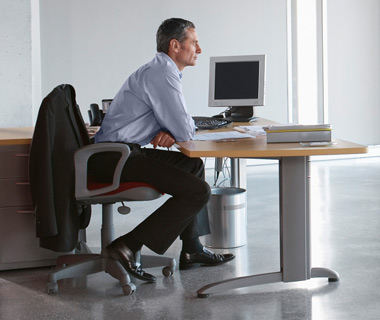For many of us, a daily dilemma goes something like this: “I should go to the gym!” “I don’t want to go to the gym!” “But I should go to the gym!”
Our internal compasses and the culture at large compel us to exercise for fitness, health and physical attractiveness. But here’s the paradox you may not be aware of: Even daily gym workouts won’t reverse the damage you incur by sitting at your desk all day.
A considerable body of research has documented that the cumulative impact of sitting over years can lead to obesity, diabetes, cardiovascular disease and even certain kinds of cancer. And while bursts of physical activity, like a visit to the gym, have benefits, they cannot make up for the average five hours and 41 minutes most Americans spend each day sitting at their desks.
Sitting: The New Smoking
Sitting, as it turns out, is dangerous for your health. Those on the forefront of the “get up and move” movement liken it to tobacco. Their battle cry: “Sitting is the new smoking.”
“Sitting is very bad,” intones Mayo Clinic endocrinologist Dr. James Levine, author of the recently published Get Up: Why Your Chair is Killing You and What You Can Do About It. “Excessive sitting is associated with 34 chronic diseases and conditions including obesity, diabetes, cancer, depression and back pain. People need to be given the option and opportunity to get up during their work day.”
In his study of office workers, Levine, who is director of the Institute of Obesity Solutions at Mayo Clinic/Arizona State University, found that participants who got up from their desks and walked around an average of 2.25 hours more a day tended to be thin as opposed to those who sat still. Everyone ate the same food, and no one was going to the gym.
Researchers have also found that sitting for prolonged periods is associated with the body’s reduced effectiveness in regulating levels of glucose, which dramatically increases the chance of Type 2 diabetes. A 2010 study by researchers at the American Cancer Society and published in the American Journal of Epidemiology suggests that people who sit for long periods during their leisure time have a shorter average life span of two years, and sedentary behavior accounts for increased incidence of breast and colon cancers. While the underlying reasons are still unclear, important markers such as C-Reactive Protein (CRP), which is associated with cancer-causing inflammation, tend to be higher in people who sit for a long time.
The good news is that it doesn’t take much to move around during the day and counter some of these negative outcomes.
5 Tips to Spend Less Time Sitting
Here are five ways and means that will force you to get up and move around (and you don’t even have to give up your gym membership):
1. Take the stairs instead of elevators, whenever you can. (No, we don’t expect you to climb 101 floors in a skyscraper.)
2. Minimize inter-office emails. Walk down the hall to deliver a message in person.
3. Wear a hand-free headset set. Don’t sit at your desk and make telephone calls. Get a headset and stand up and talk. You will find yourself naturally pacing around your office.
4. Take frequent walking breaks. Rather than your daily dose of water cooler gossip, take a walking gossip break with co-workers.
5. Request a stand-up desk and other movement-oriented solutions. Stand-up desks that clamp onto a workstation are the latest cool office craze, and they really work. A 2011 study published by the Centers for Disease Control and Prevention showed that when workers are equipped with sit-stand workstations, prolonged sitting is reduced and moods improve. However, there are other desk solutions that facilitate movement, such as walking treadmills and stability balls. Talk to your employer about these.
While it might seem that standing at a desk doesn’t translate into movement, in fact, Levine says when people stand they tend to move around in place. “They wobble from foot to foot and do half-step pacing. Standing has proven to be very beneficial and quite inexpensive,” he says.
Moreover, office workers who are standing are more likely to walk across the room to give a message to someone. “They have a sense that if they’re standing they might as well walk around,” continues Levine. “And pretty soon you have an office where people are moving around all the time.”
A number of these office behaviors will require approval and support from your boss. But as evidence mounts, employers are amenable to implementing policies that support employees moving around rather than sitting at their desks for eight hours. It’s good for their health, and what’s good for their health is good for the bottom line.
From: Next Avenue

